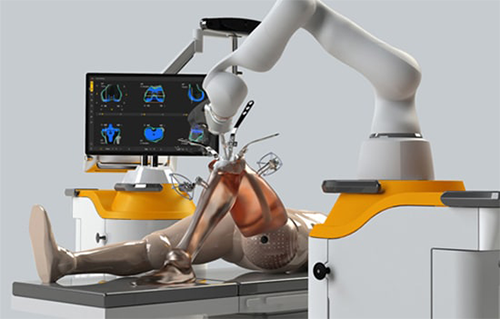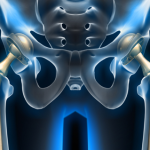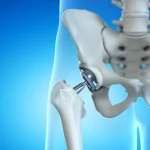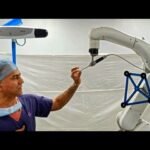A robotic knee replacement is similar to a traditional knee replacement. Your surgeon removes damaged tissue in your knee and replaces it with an artificial joint. The difference is that it’s done with assistance from a robotic arm, which allows for greater precision. In more complex cases, a robotic-assisted knee replacement offers a better balance in the soft tissues around your knee, and better aligns the joint.
If you’re having a robotic-assisted knee replacement surgery, you don’t have to prepare any differently than you would for conventional surgery.
We will discuss all knee replacement options available to you, including whether you are a good candidate for robotic joint replacement.
How do Robotic Knee Replacement Work?
With robotic knee replacement surgery, physicians can perform accurate and tailored knee joint replacement treatments with the use of cutting-edge technology. Here’s a succinct explanation of how it functions:
• Preoperative Planning:
Based on the patient’s knee joint, surgeons utilize 3D imaging to construct a customized surgical plan.
• Surgical Mapping:
Taking into account the patient’s particular anatomy and knee joint injury, the surgical plan specifies the precise location of the artificial knee components.
• Robotic Assistance:
During surgery, a robotic arm, a computer, and specialized software are employed as part of a robotic system.
• Registration and Calibration:
To ensure accurate instrument guidance, preoperative imaging is used to calibrate the robotic system to the patient’s anatomy.
• Intraoperative Guidance:
Using the robotic arm for incisions and joint preparation, the surgeon may precisely carry out the preoperative plan thanks to real-time input from the robotic system.
What Benefits Can Robotic Knee Replacement Surgery Offer ?
When compared to conventional surgery, robotic-assisted knee replacement has a number of benefits. Advantages include:
• Enhanced surgical planning:
Specialized 3-D images are taken in preparation for and during surgery. These images help your surgeon more accurately plan the optimal type and placement of your replacement joint to ensure the right size and fit.
• Greater precision:
Robotic technologies enhance your orthopedic surgeon’s expertise for more precise planning, tissue removal, and implant placement.
• Optimal joint alignment:
With robotic technology, your surgeon is able to better align and position your knee implant. This helps ensure a more natural-feeling joint replacement and creates less friction and wear on your new joint..
Get whatever assistive devices you might require following a knee replacement.
What do you need at home after a knee surgery?
There’s assistive equipment available to help you do certain activities like walking, getting dressed, or using the restroom. These devices also help keep you safe as you recover.
Depending on your condition after surgery, some of the most common devices you may need are:
• Walking aids like crutches, a cane, or a walker
• Shoehorns and sock aids
• Grab bars around your home
• Reachers and tongs
• Raised toilet seat
• Tub chair
Other items that will help you feel more comfortable can include:
• Ice packs or wraps to help with any swelling and related pain
• Extra pillows to elevate and support your leg when you’re sitting down
• Comfortable, loose-fitting shorts or pants that won’t restrict or rub against your incision site
• Knee replacement pre-surgery exercises to help with recovery
Strengthening and conditioning your body and joints before surgery can help your recovery in a number of ways. Strengthening your upper body, for example, can make it easier to use assistive devices like crutches or a wheelchair.
Pre-knee replacement exercise can also lead to weight loss, which can help ease pressure on your knees before and after the procedure. In fact, studies show losing one pound of weight can relieve four pounds of pressure on your knees.
As for the kind of exercises you can do before knee replacement surgery, lower-impact exercises and activities like yoga, biking, or swimming can be good candidates – especially if you’re in pain.
For example, using a regular or stationary exercise bike before a knee replacement is a low impact, helping you manage joint pain while improving muscle strength, endurance, and range of motion.
Here is a list of 7 things you should know about robotic knee replacement surgery:
• Candidates for robotic knee replacement surgery:
The requirement for knee replacement with robotics is the same as the traditional one. The doctor would first go for less invasive methods like anti-inflammatory medication, cortisone doses, physical therapy, weight loss, and knee braces. Knee replacement is a suitable option if you don’t get relief from these methods. Surgery is not a good option for patients above the age of 60.
Robotic knee replacement places the implant precisely, ensuring a higher success rate. Still, joint replacement is not a permanent solution and discuss it with your doctor while considering it.
• Robots do the surgery:
On hearing about robotic-assisted knee replacement, people are misguided by the name and think it is done by robots. The surgery is done under the supervision of an orthopedic surgeon. The robot arm helps in higher accuracy. Before the surgery, a CT scan helps obtain a 3D model of the knees. It helps the surgeon during the surgery to avoid damage to other tissues.
• Lesser recovery time:
Robotic total knee replacement has a relatively shorter recovery period. Since it is still relatively new in the healthcare field, enough benefits are not yet known. The recovery time for a patient of traditional knee replacement to resume daily life activities is 4 to 6 weeks. With robotic knee surgery, it is reduced by 50%. The reason is smaller incisions hence lesser damage to the surrounding bone and tissues.
• Higher accuracy can improve recovery:
With the help of advancements, robotic knee surgery is more accurate. The surgeon can carry out the surgery by customizing knee replacements per the patient’s anatomy. It gives the patient a more natural and real feeling in some cases.
After the surgery, most patients suffer from joint awareness. Under ideal circumstances, your knee replacement should not be felt at any time as you go about your daily life activities. However, in many cases, the patients face problems performing routine activities like walking down the stairs, bowing, or sitting down. They tend to feel pain in the area, numbness, and stiffness of the joint.
More studies are needed to check the extent to which joint awareness can be decreased with a robotic total knee replacement. However, doctors are optimistic about the precision and benefits of the use of robotic arms.
• Practical experience above all:
State-of-the-art robotic techniques have enhanced the results for patients, but they can not replace the experience of an excellent orthopedic surgeon. Whether you need a robotic partial knee replacement surgery or a complete one, you should still choose an orthopedic surgeon who has vast knowledge and real-time experience.
• Potential risks:
Here is a list of risks in traditional as well as robotic knee surgery:
Nerve damage
Infection
The allergic reaction by the immunity system to the artificial joint.
Deep vein thrombosis (blood clots formation)
With the help of robots, the surgery can be performed with higher accuracy, and the rate of complications comes down. The chances of serious complications are quite rare. Only 2% of the patients get severe complications. The doctor would diagnose your condition correctly before the surgery and discuss the potential risks and side effects that may happen during or after the surgery.
• More data is required:
Though we have proven short-term benefits of robotic-assisted knee replacement, more information is needed to see the long-term benefits of the higher accuracy obtained with this method.
If you want more information about partial or total knee replacement, visit Germantown Hospital. Our experts can also help you with an excellent robotic-assisted total knee replacement.
Also Read: MSI Knee Replacement Surgery
Conclusion:
Robotic knee replacement surgery offers a promising advancement in the field of orthopedics. Its precision, customization, and potential for improved outcomes make it a compelling option for many patients. However, whether it is the best choice depends on individual factors such as the patient’s condition, surgeon’s expertise, and available technology. Consulting with a medical professional and discussing the pros and cons can help determine if robotic knee replacement surgery is the right fit for each patient’s unique needs.








Great share!” Thanks for sharing these kind of information with us.